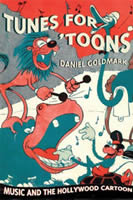Loony for Tunes
|
Ethelbert Nevin [December 2005.]
Tunes for ’Toons: Music and the Hollywood Cartoon, by Daniel Goldmark. University of California Press, 2005 (http://www.ucpress.edu/). If you can sing the tune to “The Merry-Go-Round Broke Down,” or if Carl Stalling and Scott Bradley are household names, then this is the book you’ve been waiting for. Tunes for ’Toons: Music and the Hollywood Cartoon is the first serious examination of the golden age of cartoon scoring (ca. 1930-50). Goldmark has been a cartoon fanatic for quite a while. With this book under his belt, this Case Western faculty member becomes perhaps the first cartoon-music scholar-historian. Indeed, his vast range of sources — cartoons, obscure periodicals, others’ self-published tomes, industry press materials, etc. — reveals a ravenous appetite. Stalling and Bradley each receive a chapter. Stalling was the major force behind the Looney Tunes and Merrie Melodies scores. Bradley, perhaps the more original composer, is best remembered for his Tom and Jerry work. Beyond composer biographies, we learn about the symbiosis of sound and image, and cartoon assemblage. Anecdotes about Stalling’s days as a theatre organist explain the genre’s beginning. (Someone ought to write a history of the studio orchestras that played the music.) When you think about it, the relationship between animation and music is various and bizarre. Music may accompany the screen action passively: Elmer Fudd strolling to a 2/4 beat. Sometimes it actively accompanies: Tweety singing, backed by full orchestra. Elsewhere the music amplifies action, especially when animated characters undergo transformations impossible in the physical world: Jerry hits Tom with a frying pan; as his face flattens to register the impact, we hear a gong. Sometimes the music itself is the subject, with the characters reacting to it or appearing to control it: An orchestra tunes and a tuxedoed Bugs steps up to the podium to conduct. Goldmark refers to Michel Chion’s perceptive writings on this subject. Cartoon enthusiasts know the “Kill the wabbit” lyric to Wagner’s Ride of the Valkyries. Two thought-provoking chapters discuss classical music’s uses and abuses. Consider that many folks first experience classical music through cartoons. Is this distorted exposure better than nothing, or is it bad because “great music” is cheapened by association? It’s really no longer a relevant debate, and Goldmark doesn’t press either point. For some, cartoons may have tainted a wide swath of the classical repertoire. Perhaps there are those who can’t take opera quite as seriously after Bugs and Elmer Fudd skewer Wagner in What’s Opera, Doc? Perhaps, having seen Rhapsody Rabbit, there are those who have difficulty listening to Liszt’s Hungarian Rhapsody No. 2. You could argue that the Lone Ranger spoiled the William Tell Overture. (Wait! Maybe Shostakovich’s 15th is really a cartoon score!) Then again, Fantasia had wonderful consequences, and, to a lesser extent, so did Allegro Non Troppo. This debate is also no longer relevant. The environment has been supersaturated with music transformed by advertising, Muzak, ring-tones, video games, door-bells, etc. No one really wonders whether what he or she hears is truly original or out of context. With elevators and cell-phones having acquired their own musical genres, it will come as no surprise to a young listener that cartoons employed classical music. The “Jungle Jive: Animation, Jazz Music and Swing Culture” chapter treads delicately on jazz and stereotypes. Sensibly banished from today’s Saturday-morning rotation are cartoons that fed jingoistic and racist caricatures during WWII, or those which equated jazz and its players with jungle dwellers. Ponder what such images did to generations of impressionable minds. Outside of jazz, what does it mean that traditional cartoon music is largely tonal? Is there a place for dissonance in mainstream animation? Why not a collection of Schnittke’s cartoon scores? Is atonality really only good for expressing fear, anger or uncertainty? George Rochberg though so. At this point, I must mention the brilliant Ernie Kovacs, who set his bizarre TV tableaux to Bartók, though gorillas jetéing to Swan Lake may be the more enduring Kovacsian touch. A book concerned with music ought to contain some score examples. Beyond a few bars of Raymond Scott’s Powerhouse — you’d recognize the tune even if you don’t know it by name (get “The Music of Raymond Scott,” Columbia CK 52028, or listen here) — their absence disappoints. I suspect that Goldmark’s hands were tied. The best cartoon music is still under copyright. It’s to the studios’ advantage to keep these tunes out of the public domain. Unfortunately, the few notes the author includes are other than germane. Further, Goldmark identifies a sequence of 16 pitches as one of Bradley’s “12-tone scales,” and yet it’s not strictly serial. Furthermore, when are pitch sets denoted as scales? While the scholarship fascinates, one ultimately tires of cartoon information. Goldmark does include stills, but in the absence of moving pictures, it’s difficult to follow some of his analyses. Licensing probably nixed an accompanying DVD. Warner has released multi-DVD Looney Toons sets, indispensable for fans. (Goldmark supplies audio commentary for some of the tracks.) Rhino offers a relevant two-disc audio collection here. There are “The Carl Stalling Project: Music From Warner Bros. Cartoons, 1936-1958,” Warner 9 26027-2, and “The Carl Stalling Project, Volume 2: More Music From Warner Bros. Cartoons 1939-1957,” Warner 9 45430-2, and six Bradley scores on “Tex Avery Cartoons,” BMG Milan 7313835635-2. “Th-th-th-th-that’s all, f-f-f-folks.”
[More Ethelbert Nevin]
[Previous Article:
“Come io passo l’estate”: Italian Vacation 3.]
[Next Article:
The Musical Moment]
|
